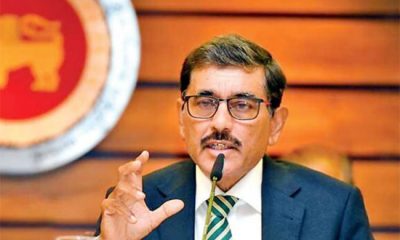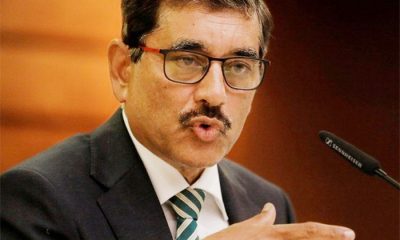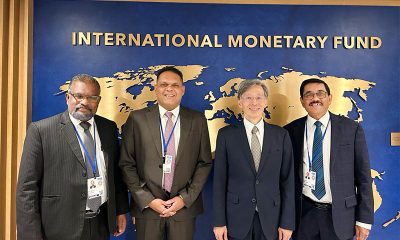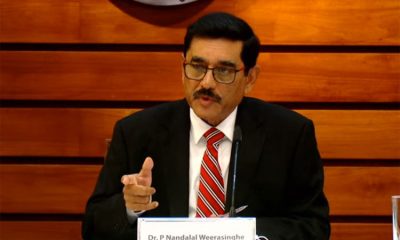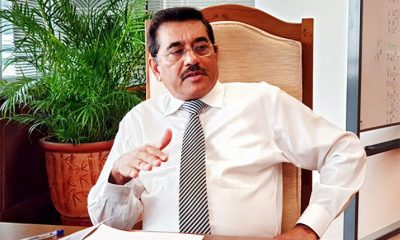Features
Inflation – Public Enemy Number One
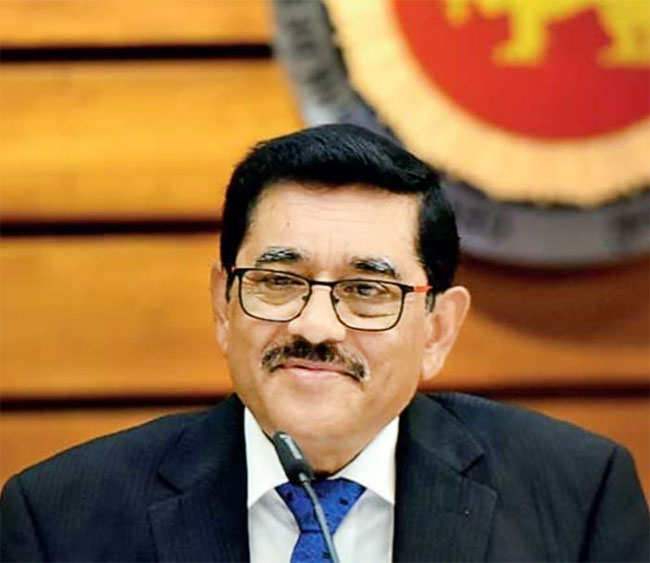
[An article based on the Keynote Address delivered by Dr. P. Nandalal Weerasinghe, Governor of the Central Bank of Sri Lanka, recently at the Annual Research Symposium 2023 of the University of Colombo]
Introduction
Inflation affects every aspect of our lives; it is a force that shapes our purchasing power, influences our financial decisions, and impacts the overall stability of our society. In the year 2022, inflation reached extraordinary levels globally, driven by the lagged effects of ultra-easy monetary and fiscal support following the COVID-19 pandemic, supply shortages and capacity constraints, along with supply chain issues. Affected by global as well as domestic factors, Sri Lanka also experienced inflation at unprecedented levels in 2022. However, in late 2022, Sri Lanka entered an impressive disinflation path, eventually bringing inflation down to the targeted levels within a period of one year. Sri Lanka’s swift disinflationary process was supported by a combination of policy measures implemented by both the Central Bank and the Government.
In the forthcoming sections, I will delve into international experience and the academic outcomes on the causes and consequences of inflation; the role of monetary policy in coping with inflation; the dynamics of Sri Lanka’s high inflation episode; and the role of the Central Bank of Sri Lanka in managing inflation and inflation expectations, with special emphasis to the new Central Bank of Sri Lanka Act. A better understanding of the above could help shape academic research, which would also contribute towards effective policymaking and business decisions.
Declaring inflation as a public enemy
Inflation, a fundamental concept in economics, refers to the sustained increase in the general price level of goods and services in an economy over a period of time. When inflation occurs, each unit of currency buys fewer goods and services than it did before, leading to a decrease in the purchasing power of money. Over the years, economists and policymakers emphasised the seriousness and negative impact of inflation on the economy and people’s lives.
High inflation episodes have been a recurring phenomenon in economic history, causing significant challenges for nations and their citizens. It was in this context that Gerald Ford, the 38th president of the United States, even declared inflation as public enemy number one. In one of President Ford’s addresses to Congress in 1974 he stated “Only two of my predecessors have come in person to call upon Congress for a declaration of war, and I shall not do that. But I say to you with all sincerity that our inflation, our public enemy number one, will, unless whipped, destroy our country, our homes, our liberties, our property, and finally our national pride, as surely as any well-armed wartime enemy.” President Ford introduced the slogan “Whip Inflation Now (WIN)” as part of his campaign to fight inflation and even started wearing buttons with “WIN”. Although the outcome of this campaign is debatable, it illustrates how much of a problem inflation was in the 1970s.
Historical episodes of high inflation
Indeed, many countries have grappled with high inflation – and in some cases hyperinflation. One of the most infamous cases of hyperinflation occurred in Germany during the early 1920s. Following World War I, Germany experienced a severe economic crisis exacerbated by the reparations imposed by the Treaty of Versailles. The German government printed an excessive amount of money to meet its obligations, leading to hyperinflation. Prices skyrocketed, and people’s savings became worthless. At its peak, prices were doubling every few days, and workers were paid multiple times a day. Zimbabwe, in the late 2000s, faced hyperinflation due to a combination of economic mismanagement, land reforms, and political instability. The government printed money recklessly, causing prices to soar at an astronomical rate. At its peak, in mid-November 2008, Zimbabwe’s hyperinflation reached an astounding monthly rate of around 500 billion per cent (Moyo, 2023). The Zimbabwean dollar became practically worthless, and the country abandoned its own currency, relying on foreign currencies for transactions. Similarly, countries such as Argentina, Brazil and Venezuela experienced hyperinflation crises from time to time since the 1980s.
Why high inflation or hyperinflation is bad?
Inflation represents how much more expensive the relevant set of goods or services has become over a certain period, most commonly a year. To the extent that households’ nominal income does not increase as much as prices, they are worse off, because they can afford to purchase less. In other words, households’ purchasing power or real income (inflation-adjusted income) falls. Real income is a proxy for the standard of living. When real incomes are rising, so is the standard of living, and vice versa.
Savers and investors suffer significant losses during periods of high inflation. The real value of savings diminishes rapidly, while investors experience a decline in the real returns of their investments. Moreover, high inflation breeds uncertainty in the economy. Businesses face difficulties in planning for the future, unsure of their future costs and revenues. This uncertainty leads to reduced investments and hampers economic growth. Furthermore, nations experiencing high inflation find their international competitiveness severely compromised. As domestic prices rise, the cost of exports increases, making products less competitive in the global market. This situation can lead to trade imbalances and hinder economic recovery efforts, further exacerbating the challenges posed by high inflation.
Although high inflation hurts an economy, deflation, or falling prices, is not desirable either. When prices are falling, consumers delay making purchases if they can, anticipating lower prices in the future. For the economy, this means less economic activity, less income generated by producers, and lower economic growth. As you may know, Japan is one country with a long period of nearly no economic growth, largely because of deflation. Given the above, most economists now believe that low, stable, and most importantly predictable inflation is good for an economy. If inflation is low and predictable, it is easier to capture it in price-adjustment contracts and interest rates, reducing its distortionary impact.
What causes inflation?
Inflation could be influenced by numerous factors. Understanding these diverse causes of inflation is essential for academics as well as policymakers to recommend and implement appropriate measures to maintain stable prices and support sustainable economic growth. Demand-pull inflation occurs when the demand for goods and services exceeds their supply. When the demand outstrips supply, businesses often raise prices to maximise their profits. Cost-push inflation occurs when the cost to produce goods and services increases, leading businesses to pass these additional costs on to consumers in the form of higher prices. This can be caused by rising wages, increased costs of raw materials, or other production-related expenses. Expectations also play a key role in determining inflation. If people or firms anticipate higher prices, they build these expectations into wage negotiations and contractual price adjustments. To the extent that people base their expectations on the recent past (adaptive expectations), inflation would follow similar patterns over time, resulting in inflation inertia.
In the long run, inflation is primarily caused by factors related to the overall increase in the money supply in an economy relative to the growth in the real output of goods and services. If the money supply grows too big relative to the size of an economy, the unit value of the currency diminishes; in other words, its purchasing power falls and prices rise. Milton Friedman, a Nobel laureate in economics, argued that “inflation is always and everywhere a monetary phenomenon.” Friedman argued that changes in the money supply, driven by central bank policies and other monetary factors, are the primary drivers of inflation in the long run, while other factors can cause short-term fluctuations in prices. While Friedman’s insight into the monetary roots of inflation remains a fundamental principle, economists and policymakers now consider a broader array of factors when analysing inflationary trends. Modern economic analysis incorporates a more holistic approach, recognising the interplay of various elements in shaping inflationary outcomes.
How policymakers deal with inflation and the role of monetary policy
The policies aimed at reducing inflation depend to a great extent on the causes of inflation. If the economy has overheated and inflation is primarily demand-driven, central banks can implement contractionary monetary policy that rein in aggregate demand. Indeed, the central banks play a crucial role in controlling inflation through monetary policy.
One of the primary objectives of monetary policy, as emphasised by many central banks around the world, is maintaining price stability. Price stability is crucial for a healthy economy as it ensures that the purchasing power of a currency remains relatively constant over time. Economists have argued that stable prices create a favourable environment for long-term economic growth and investment (e.g., Mishkin, 2007). Moreover, monetary policy also plays a role in promoting economic growth. Studies by Romer (1993) and Barro and Sala-i-Martin (2004) suggest that stable monetary policies are positively correlated with long-term economic growth.
Central banks use a range of tools to influence the money supply and interest rates, affecting inflation. Traditional tools include policy interest rates, open market operations, and reserve requirements. Following the 2008 financial crisis, central banks implemented unconventional monetary policies, such as forward guidance, quantitative easing (asset purchasing) and negative interest rates. Furthermore, central bankers are increasingly relying on their ability to influence inflation expectations as an inflation-reduction tool. Policymakers announce their intention to keep economic activity low temporarily to bring down inflation, hoping to influence expectations. The more credibility central banks have, the greater the influence of their pronouncements on inflation expectations.
However, monetary policy is faced with increasing challenges and trade-offs. For example, the Phillips curve, which describes the inverse relationship between inflation and unemployment or output, has been the subject of extensive research. Studies that integrate monetary policy, inflation, and output stabilisation, have provided insights into the trade-offs faced by policymakers (e.g., Clarida, Gali, and Gertler, 1999) when achieving price stability. Furthermore, with increased globalisation, international factors can have a heightened impact on domestic inflation (e.g., Obstfeld and Rogoff, 2002). This sheds light on the complexities of maintaining price stability in a globalised world.
Across the globe, monetary policy frameworks cover various approaches, strategies, and models employed by central banks to achieve their objectives, such as price stability. Among those, inflation targeting has been a widely adopted monetary policy framework since the 1990s. Under inflation targeting, central banks set explicit inflation targets and use policy instruments to achieve them. Studies show that countries adopting inflation targeting are benefited in terms of providing clear objectives to the stakeholders and enhanced transparency (Bernanke, Laubach, Mishkin, and Posen, 1999). Many central banks have moved toward flexible inflation targeting, a special case of inflation targeting, which allows temporary deviations from the target to accommodate shocks to the real economy. Flexible inflation targeting has its advantages in terms of stabilising both inflation and the real economy (Svensson, 2010).
Global inflation in 2023
Despite the advances in monetary policy frameworks, across the globe, inflation accelerated to unprecedented levels during the year 2022. According to the IMF, global inflation accelerated to 8.7 per cent in 2022, from 4.7 per cent in the previous year, reflecting the impact of the lagged effects of ultra-easy monetary and fiscal support following the COVID-19 pandemic, shortages of fuel and nonfuel commodities exacerbated by the Russia-Ukraine conflict, and capacity constraints along with supply chain issues. Many countries allowed the passthrough of high global prices to the domestic economy, as administrative price-setting measures that are not cost-reflective usually result in the government’s accrual of large subsidy bills to compensate producers for their lost income.
However, in light of substantial monetary tightening by major central banks in the world, the resultant slowing of economic activity, easing supply chain disruptions, and moderating prices of energy and other commodities, inflation started to moderate in 2023. Nonetheless, the forecast levels of inflation in 2023 and 2024 are still higher than the pre-pandemic (2017–2019) levels of around 3.5 per cent. Moreover, the underlying price pressures are proving sticky, with labour markets tight in several economies. Therefore, core (underlying) inflation is likely to decline more slowly in the period ahead. Further, with rising geopolitical tensions in the Middle East, upside risks to global inflation are on the rise.
Sri Lanka’s economic crisis and the rise in inflation
In 2022, Sri Lanka experienced its worst-ever economic crisis, which had been in the making for many years, triggered by policy errors and exacerbated by other exogenous factors. Failure to build fiscal and external buffers over time made the nation vulnerable to domestic and external shocks, and the COVID-19 pandemic and the related shocks exposed the vulnerabilities in the Sri Lankan economy, bringing about the worst economic crisis in Sri Lanka’s history. The resultant economic hardship led to public anxiety and political upheavals.
By early 2022, the economy faced severe challenges due to an unsustainable macroeconomic model along with persistent budget deficits and external account imbalances. These issues, influenced by global and domestic factors, had depleted the economy’s foreign reserves. As a result, the country experienced intense pressure on its balance of payments (BOP), leading to a shortage of foreign exchange, a weakened exchange rate, soaring inflation, and reduced economic activity.
Although Sri Lanka managed to have single-digit inflation for over 12 years since 2009, inflation rose to historically high levels in 2022 stemming from global oil and other commodity price hikes, adjustments to domestic administrative prices, domestic supply disruptions, the substantial depreciation of the Sri Lanka rupee against the US dollar and the lagged effects of extended period of relaxed monetary policy following the COVID-19 pandemic. Contrary to the co-movement in inflation and economic growth in regular business cycles, Sri Lanka witnessed inflation and economic growth moving in opposite directions, as supply, as well as demand-driven inflation, accelerated overall inflation and economic growth stalled.
Measures taken to overcome the sharp rise in inflation
Several policy measures have been taken by the Central Bank to stabilise the economy and tighten monetary and credit conditions. With a view to countering rising inflationary pressures and anchoring inflation expectations, the Central Bank tightened monetary policy significantly since August 2021, with a significant increase in policy interest rates happening in April 2022. Monetary policy had to be conducted with an unprecedented level of deliberations, as the country entered a phase of high inflation and economic stagnation and tightening of monetary conditions will not only result in a reduction in inflation, but also economic growth. In parallel, the Central Bank also implemented a series of policy measures aimed at maintaining external sector stability and reducing import demand.
Since the beginning of the monetary tightening cycle in August 2021, the Central Bank’s key policy interest rates, i.e., Standing Deposit Facility Rate (SDFR) and Standing Lending Facility Rate (SLFR), were raised by 11 percentage points till March 2023. Furthermore, during this tightening phase, the Central Bank increased the Statutory Reserve Ratio (SRR) by 2 percentage points, while several caps on interest rates were removed, allowing for greater upward adjustments in market interest rates. The unprecedented upward adjustment of policy interest rates helped arrest the further build-up of demand-driven inflationary pressures, thereby pre-empting the escalation of adverse inflationary expectations, easing the pressure on the external sector, and correcting anomalies observed in the market interest rate structure.
(To be continued)
Features
The heart-friendly health minister

by Dr Gotabhya Ranasinghe
Senior Consultant Cardiologist
National Hospital Sri Lanka
When we sought a meeting with Hon Dr. Ramesh Pathirana, Minister of Health, he graciously cleared his busy schedule to accommodate us. Renowned for his attentive listening and deep understanding, Minister Pathirana is dedicated to advancing the health sector. His openness and transparency exemplify the qualities of an exemplary politician and minister.
Dr. Palitha Mahipala, the current Health Secretary, demonstrates both commendable enthusiasm and unwavering support. This combination of attributes makes him a highly compatible colleague for the esteemed Minister of Health.
Our discussion centered on a project that has been in the works for the past 30 years, one that no other minister had managed to advance.
Minister Pathirana, however, recognized the project’s significance and its potential to revolutionize care for heart patients.
The project involves the construction of a state-of-the-art facility at the premises of the National Hospital Colombo. The project’s location within the premises of the National Hospital underscores its importance and relevance to the healthcare infrastructure of the nation.
This facility will include a cardiology building and a tertiary care center, equipped with the latest technology to handle and treat all types of heart-related conditions and surgeries.
Securing funding was a major milestone for this initiative. Minister Pathirana successfully obtained approval for a $40 billion loan from the Asian Development Bank. With the funding in place, the foundation stone is scheduled to be laid in September this year, and construction will begin in January 2025.
This project guarantees a consistent and uninterrupted supply of stents and related medications for heart patients. As a result, patients will have timely access to essential medical supplies during their treatment and recovery. By securing these critical resources, the project aims to enhance patient outcomes, minimize treatment delays, and maintain the highest standards of cardiac care.
Upon its fruition, this monumental building will serve as a beacon of hope and healing, symbolizing the unwavering dedication to improving patient outcomes and fostering a healthier society.We anticipate a future marked by significant progress and positive outcomes in Sri Lanka’s cardiovascular treatment landscape within the foreseeable timeframe.
Features
A LOVING TRIBUTE TO JESUIT FR. ALOYSIUS PIERIS ON HIS 90th BIRTHDAY

by Fr. Emmanuel Fernando, OMI
Jesuit Fr. Aloysius Pieris (affectionately called Fr. Aloy) celebrated his 90th birthday on April 9, 2024 and I, as the editor of our Oblate Journal, THE MISSIONARY OBLATE had gone to press by that time. Immediately I decided to publish an article, appreciating the untiring selfless services he continues to offer for inter-Faith dialogue, the renewal of the Catholic Church, his concern for the poor and the suffering Sri Lankan masses and to me, the present writer.
It was in 1988, when I was appointed Director of the Oblate Scholastics at Ampitiya by the then Oblate Provincial Fr. Anselm Silva, that I came to know Fr. Aloy more closely. Knowing well his expertise in matters spiritual, theological, Indological and pastoral, and with the collaborative spirit of my companion-formators, our Oblate Scholastics were sent to Tulana, the Research and Encounter Centre, Kelaniya, of which he is the Founder-Director, for ‘exposure-programmes’ on matters spiritual, biblical, theological and pastoral. Some of these dimensions according to my view and that of my companion-formators, were not available at the National Seminary, Ampitiya.
Ever since that time, our Oblate formators/ accompaniers at the Oblate Scholasticate, Ampitiya , have continued to send our Oblate Scholastics to Tulana Centre for deepening their insights and convictions regarding matters needed to serve the people in today’s context. Fr. Aloy also had tried very enthusiastically with the Oblate team headed by Frs. Oswald Firth and Clement Waidyasekara to begin a Theologate, directed by the Religious Congregations in Sri Lanka, for the contextual formation/ accompaniment of their members. It should very well be a desired goal of the Leaders / Provincials of the Religious Congregations.
Besides being a formator/accompanier at the Oblate Scholasticate, I was entrusted also with the task of editing and publishing our Oblate journal, ‘The Missionary Oblate’. To maintain the quality of the journal I continue to depend on Fr. Aloy for his thought-provoking and stimulating articles on Biblical Spirituality, Biblical Theology and Ecclesiology. I am very grateful to him for his generous assistance. Of late, his writings on renewal of the Church, initiated by Pope St. John XX111 and continued by Pope Francis through the Synodal path, published in our Oblate journal, enable our readers to focus their attention also on the needed renewal in the Catholic Church in Sri Lanka. Fr. Aloy appreciated very much the Synodal path adopted by the Jesuit Pope Francis for the renewal of the Church, rooted very much on prayerful discernment. In my Religious and presbyteral life, Fr.Aloy continues to be my spiritual animator / guide and ongoing formator / acccompanier.
Fr. Aloysius Pieris, BA Hons (Lond), LPh (SHC, India), STL (PFT, Naples), PhD (SLU/VC), ThD (Tilburg), D.Ltt (KU), has been one of the eminent Asian theologians well recognized internationally and one who has lectured and held visiting chairs in many universities both in the West and in the East. Many members of Religious Congregations from Asian countries have benefited from his lectures and guidance in the East Asian Pastoral Institute (EAPI) in Manila, Philippines. He had been a Theologian consulted by the Federation of Asian Bishops’ Conferences for many years. During his professorship at the Gregorian University in Rome, he was called to be a member of a special group of advisers on other religions consulted by Pope Paul VI.
Fr. Aloy is the author of more than 30 books and well over 500 Research Papers. Some of his books and articles have been translated and published in several countries. Among those books, one can find the following: 1) The Genesis of an Asian Theology of Liberation (An Autobiographical Excursus on the Art of Theologising in Asia, 2) An Asian Theology of Liberation, 3) Providential Timeliness of Vatican 11 (a long-overdue halt to a scandalous millennium, 4) Give Vatican 11 a chance, 5) Leadership in the Church, 6) Relishing our faith in working for justice (Themes for study and discussion), 7) A Message meant mainly, not exclusively for Jesuits (Background information necessary for helping Francis renew the Church), 8) Lent in Lanka (Reflections and Resolutions, 9) Love meets wisdom (A Christian Experience of Buddhism, 10) Fire and Water 11) God’s Reign for God’s poor, 12) Our Unhiddden Agenda (How we Jesuits work, pray and form our men). He is also the Editor of two journals, Vagdevi, Journal of Religious Reflection and Dialogue, New Series.
Fr. Aloy has a BA in Pali and Sanskrit from the University of London and a Ph.D in Buddhist Philosophy from the University of Sri Lankan, Vidyodaya Campus. On Nov. 23, 2019, he was awarded the prestigious honorary Doctorate of Literature (D.Litt) by the Chancellor of the University of Kelaniya, the Most Venerable Welamitiyawe Dharmakirthi Sri Kusala Dhamma Thera.
Fr. Aloy continues to be a promoter of Gospel values and virtues. Justice as a constitutive dimension of love and social concern for the downtrodden masses are very much noted in his life and work. He had very much appreciated the commitment of the late Fr. Joseph (Joe) Fernando, the National Director of the Social and Economic Centre (SEDEC) for the poor.
In Sri Lanka, a few religious Congregations – the Good Shepherd Sisters, the Christian Brothers, the Marist Brothers and the Oblates – have invited him to animate their members especially during their Provincial Congresses, Chapters and International Conferences. The mainline Christian Churches also have sought his advice and followed his seminars. I, for one, regret very much, that the Sri Lankan authorities of the Catholic Church –today’s Hierarchy—- have not sought Fr.
Aloy’s expertise for the renewal of the Catholic Church in Sri Lanka and thus have not benefited from the immense store of wisdom and insight that he can offer to our local Church while the Sri Lankan bishops who governed the Catholic church in the immediate aftermath of the Second Vatican Council (Edmund Fernando OMI, Anthony de Saram, Leo Nanayakkara OSB, Frank Marcus Fernando, Paul Perera,) visited him and consulted him on many matters. Among the Tamil Bishops, Bishop Rayappu Joseph was keeping close contact with him and Bishop J. Deogupillai hosted him and his team visiting him after the horrible Black July massacre of Tamils.
Features
A fairy tale, success or debacle

Sri Lanka-Singapore Free Trade Agreement
By Gomi Senadhira
senadhiragomi@gmail.com
“You might tell fairy tales, but the progress of a country cannot be achieved through such narratives. A country cannot be developed by making false promises. The country moved backward because of the electoral promises made by political parties throughout time. We have witnessed that the ultimate result of this is the country becoming bankrupt. Unfortunately, many segments of the population have not come to realize this yet.” – President Ranil Wickremesinghe, 2024 Budget speech
Any Sri Lankan would agree with the above words of President Wickremesinghe on the false promises our politicians and officials make and the fairy tales they narrate which bankrupted this country. So, to understand this, let’s look at one such fairy tale with lots of false promises; Ranil Wickremesinghe’s greatest achievement in the area of international trade and investment promotion during the Yahapalana period, Sri Lanka-Singapore Free Trade Agreement (SLSFTA).
It is appropriate and timely to do it now as Finance Minister Wickremesinghe has just presented to parliament a bill on the National Policy on Economic Transformation which includes the establishment of an Office for International Trade and the Sri Lanka Institute of Economics and International Trade.
Was SLSFTA a “Cleverly negotiated Free Trade Agreement” as stated by the (former) Minister of Development Strategies and International Trade Malik Samarawickrama during the Parliamentary Debate on the SLSFTA in July 2018, or a colossal blunder covered up with lies, false promises, and fairy tales? After SLSFTA was signed there were a number of fairy tales published on this agreement by the Ministry of Development Strategies and International, Institute of Policy Studies, and others.
However, for this article, I would like to limit my comments to the speech by Minister Samarawickrama during the Parliamentary Debate, and the two most important areas in the agreement which were covered up with lies, fairy tales, and false promises, namely: revenue loss for Sri Lanka and Investment from Singapore. On the other important area, “Waste products dumping” I do not want to comment here as I have written extensively on the issue.
1. The revenue loss
During the Parliamentary Debate in July 2018, Minister Samarawickrama stated “…. let me reiterate that this FTA with Singapore has been very cleverly negotiated by us…. The liberalisation programme under this FTA has been carefully designed to have the least impact on domestic industry and revenue collection. We have included all revenue sensitive items in the negative list of items which will not be subject to removal of tariff. Therefore, 97.8% revenue from Customs duty is protected. Our tariff liberalisation will take place over a period of 12-15 years! In fact, the revenue earned through tariffs on goods imported from Singapore last year was Rs. 35 billion.
The revenue loss for over the next 15 years due to the FTA is only Rs. 733 million– which when annualised, on average, is just Rs. 51 million. That is just 0.14% per year! So anyone who claims the Singapore FTA causes revenue loss to the Government cannot do basic arithmetic! Mr. Speaker, in conclusion, I call on my fellow members of this House – don’t mislead the public with baseless criticism that is not grounded in facts. Don’t look at petty politics and use these issues for your own political survival.”
I was surprised to read the minister’s speech because an article published in January 2018 in “The Straits Times“, based on information released by the Singaporean Negotiators stated, “…. With the FTA, tariff savings for Singapore exports are estimated to hit $10 million annually“.
As the annual tariff savings (that is the revenue loss for Sri Lanka) calculated by the Singaporean Negotiators, Singaporean $ 10 million (Sri Lankan rupees 1,200 million in 2018) was way above the rupees’ 733 million revenue loss for 15 years estimated by the Sri Lankan negotiators, it was clear to any observer that one of the parties to the agreement had not done the basic arithmetic!
Six years later, according to a report published by “The Morning” newspaper, speaking at the Committee on Public Finance (COPF) on 7th May 2024, Mr Samarawickrama’s chief trade negotiator K.J. Weerasinghehad had admitted “…. that forecasted revenue loss for the Government of Sri Lanka through the Singapore FTA is Rs. 450 million in 2023 and Rs. 1.3 billion in 2024.”
If these numbers are correct, as tariff liberalisation under the SLSFTA has just started, we will pass Rs 2 billion very soon. Then, the question is how Sri Lanka’s trade negotiators made such a colossal blunder. Didn’t they do their basic arithmetic? If they didn’t know how to do basic arithmetic they should have at least done their basic readings. For example, the headline of the article published in The Straits Times in January 2018 was “Singapore, Sri Lanka sign FTA, annual savings of $10m expected”.
Anyway, as Sri Lanka’s chief negotiator reiterated at the COPF meeting that “…. since 99% of the tariffs in Singapore have zero rates of duty, Sri Lanka has agreed on 80% tariff liberalisation over a period of 15 years while expecting Singapore investments to address the imbalance in trade,” let’s turn towards investment.
Investment from Singapore
In July 2018, speaking during the Parliamentary Debate on the FTA this is what Minister Malik Samarawickrama stated on investment from Singapore, “Already, thanks to this FTA, in just the past two-and-a-half months since the agreement came into effect we have received a proposal from Singapore for investment amounting to $ 14.8 billion in an oil refinery for export of petroleum products. In addition, we have proposals for a steel manufacturing plant for exports ($ 1 billion investment), flour milling plant ($ 50 million), sugar refinery ($ 200 million). This adds up to more than $ 16.05 billion in the pipeline on these projects alone.
And all of these projects will create thousands of more jobs for our people. In principle approval has already been granted by the BOI and the investors are awaiting the release of land the environmental approvals to commence the project.
I request the Opposition and those with vested interests to change their narrow-minded thinking and join us to develop our country. We must always look at what is best for the whole community, not just the few who may oppose. We owe it to our people to courageously take decisions that will change their lives for the better.”
According to the media report I quoted earlier, speaking at the Committee on Public Finance (COPF) Chief Negotiator Weerasinghe has admitted that Sri Lanka was not happy with overall Singapore investments that have come in the past few years in return for the trade liberalisation under the Singapore-Sri Lanka Free Trade Agreement. He has added that between 2021 and 2023 the total investment from Singapore had been around $162 million!
What happened to those projects worth $16 billion negotiated, thanks to the SLSFTA, in just the two-and-a-half months after the agreement came into effect and approved by the BOI? I do not know about the steel manufacturing plant for exports ($ 1 billion investment), flour milling plant ($ 50 million) and sugar refinery ($ 200 million).
However, story of the multibillion-dollar investment in the Petroleum Refinery unfolded in a manner that would qualify it as the best fairy tale with false promises presented by our politicians and the officials, prior to 2019 elections.
Though many Sri Lankans got to know, through the media which repeatedly highlighted a plethora of issues surrounding the project and the questionable credentials of the Singaporean investor, the construction work on the Mirrijiwela Oil Refinery along with the cement factory began on the24th of March 2019 with a bang and Minister Ranil Wickremesinghe and his ministers along with the foreign and local dignitaries laid the foundation stones.
That was few months before the 2019 Presidential elections. Inaugurating the construction work Prime Minister Ranil Wickremesinghe said the projects will create thousands of job opportunities in the area and surrounding districts.
The oil refinery, which was to be built over 200 acres of land, with the capacity to refine 200,000 barrels of crude oil per day, was to generate US$7 billion of exports and create 1,500 direct and 3,000 indirect jobs. The construction of the refinery was to be completed in 44 months. Four years later, in August 2023 the Cabinet of Ministers approved the proposal presented by President Ranil Wickremesinghe to cancel the agreement with the investors of the refinery as the project has not been implemented! Can they explain to the country how much money was wasted to produce that fairy tale?
It is obvious that the President, ministers, and officials had made huge blunders and had deliberately misled the public and the parliament on the revenue loss and potential investment from SLSFTA with fairy tales and false promises.
As the president himself said, a country cannot be developed by making false promises or with fairy tales and these false promises and fairy tales had bankrupted the country. “Unfortunately, many segments of the population have not come to realize this yet”.
(The writer, a specialist and an activist on trade and development issues . )


